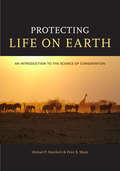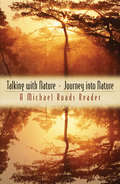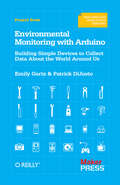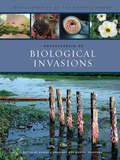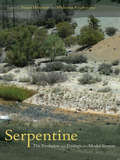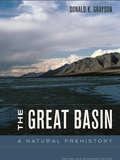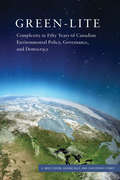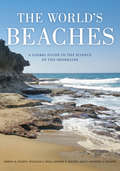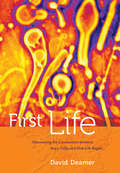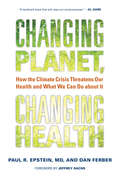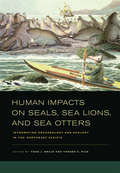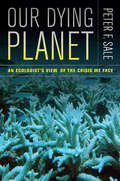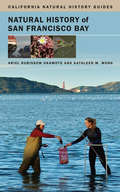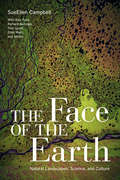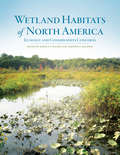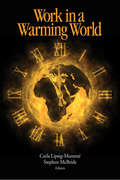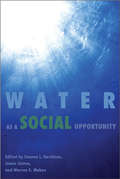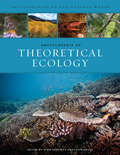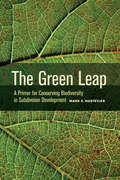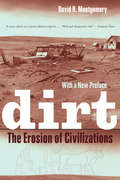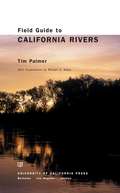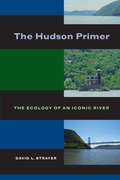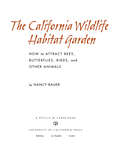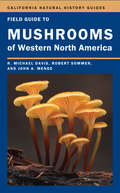- Table View
- List View
Protecting Life on Earth
by Peter B. Moyle Michael Paul MarchettiWritten to be accessible to any college-level reader, Protecting Life on Earth offers a non-technical, yet comprehensive introduction to the growing field of conservation science. This multifaceted exploration of our current biodiversity crisis delivers vivid examples throughout, including features on some of nature's most compelling wildlife. Beginning with a brief introduction to environmental history, the text introduces the central concepts of evolution and ecology, and covers several major issues related to the conservation of biodiversity including extinction, climate change, sustainability, conservation law, and invasive species. It also touches on adjacent disciples such as economics and sociology as they relate to conservation. The text even includes practical advice on the decisions we make every day--how we spend our money, where we live and work, what we eat and buy. Throughout, Protecting Life on Earth underscores the ways in which our future is tied to that of Earth's threatened species, and demonstrates exactly why conservation is so vitally important for us all.
Talking with Nature and Journey into Nature
by Michael RoadsMichael Roads had always been close to nature, but when a river started talking to him, he began to doubt his sanity. A series of encounters with the natural world followed, and Roads began to listen and let go. He found himself led stage by stage to a final wisdom, remarkable in its simplicity and in its message of hope for humanity. This book, a bind-up of his two best-known works, beautifully articulates that message.
Environmental Monitoring with Arduino
by Emily Gertz Patrick Di Justo<p>Right now, thousands of people worldwide are tracking environmental conditions with monitoring devices they’ve built themselves. You can do it too! This inspiring guide shows you how to use Arduino to create gadgets for measuring noise, weather, electromagnetic interference (EMI), water purity, and more. You’ll also learn how to collect and share your own data, and you can experiment by creating your own variations of the gadgets covered in the book. If you’re new to DIY electronics, the first chapter offers a primer on electronic circuits and Arduino programming.</p>
Encyclopedia of Biological Invasions
by Marcel Rejmanek Daniel SimberloffThis pioneering encyclopedia illuminates a topic at the forefront of global ecology--biological invasions, or organisms that come to live in the wrong place. Written by leading scientists from around the world, Encyclopedia of Biological Invasions addresses all aspects of this subject at a global level--including invasions by animals, plants, fungi, and bacteria--in succinct, alphabetically arranged articles. Scientifically uncompromising, yet clearly written and free of jargon, the volume encompasses fields of study including biology, demography, geography, ecology, evolution, sociology, and natural history. Featuring many cross-references, suggestions for further reading, illustrations, an appendix of the world's worst 100 invasive species, a glossary, and more, this is an essential reference for anyone who needs up-to-date information on this important topic. Encyclopedia of Biological Invasions features articles on: * Well-known invasive species such the zebra mussel, chestnut blight, cheatgrass, gypsy moth, Nile perch, giant African snail, and Norway rat * Regions with especially large numbers of introduced species including the Great Lakes, Mediterranean Sea, Hawaiian Islands, Australia, and New Zealand. * Conservation, ecological, economic, and human and animal health impacts of invasions around the world * The processes and pathways involved in invasion * Management of introduced species
Serpentine: The Evolution and Ecology of a Model System
by Susan Harrison Nishanta RajakarunaSerpentine soils have long fascinated biologists for the specialized floras they support and the challenges they pose to plant survival and growth. This volume focuses on what scientists have learned about major questions in earth history, evolution, ecology, conservation, and restoration from the study of serpentine areas, especially in California. Results from molecular studies offer insight into evolutionary patterns, while new ecological research examines both species and communities. Serpentine highlights research whose breadth provides context and fresh insights into the evolution and ecology of stressful environments.
The Great Basin: A Natural Prehistory (Revised and Expanded Edition)
by Donald K. GraysonCovering a large swath of the American West, the Great Basin, centered in Nevada and including parts of California, Utah, and Oregon, is named for the unusual fact that none of its rivers or streams flow into the sea. This fascinating illustrated journey through deep time is the definitive environmental and human history of this beautiful and little traveled region, home to Death Valley, the Great Salt Lake, Lake Tahoe, and the Bonneville Salt Flats. Donald K. Grayson synthesizes what we now know about the past 25,000 years in the Great Basin--its climate, lakes, glaciers, plants, animals, and peoples--based on information gleaned from the region's exquisite natural archives in such repositories as lake cores, packrat middens, tree rings, and archaeological sites. A perfect guide for students, scholars, travelers, and general readers alike, the book weaves together history, archaeology, botany, geology, biogeography, and other disciplines into one compelling panorama across a truly unique American landscape.
Green-lite
by Christopher Stoney Graeme Auld G. Bruce DoernAnchored in the core literature on natural resources, energy production, and environmental analysis, Green-lite is a critical examination of Canadian environmental policy, governance, and politics drawing out key policy and governance patterns to show that the Canadian story is one of complexity and often weak performance. Making a compelling argument for deeper historical analysis of environmental policy and situating environmental concerns within political and fiscal agendas, the authors provide extended discussions on three relatively new features of environmental policy: the federal-cities and urban sustainability regime, the federal-municipal infrastructure regime, and the regime of agreements with NGOs and businesses that often relegate governments to observing participants rather than being policy leaders. They probe the Harper era's muzzling of environmental science and scientists, Canada's oil sands energy and resource economy, and the government's core Alberta and Western Canadian political base. The first book to provide an integrated, historical, and conceptual examination of Canadian environmental policy over many decades, Green-lite captures complex notions of what environmental policy and green agendas seek to achieve in a business-dominated economy of diverse energy producing technologies, and their pollution harms and risks.
The World's Beaches
by Orrin H. Pilkey William J. Neal James Andrew Cooper Joseph T. KelleyTake this book to the beach; it will open up a whole new world. Illustrated throughout with color photographs, maps, and graphics, it explores one of the planet's most dynamic environments--from tourist beaches to Arctic beaches strewn with ice chunks to steaming hot tropical shores. The World's Beaches tells how beaches work, explains why they vary so much, and shows how dramatic changes can occur on them in a matter of hours. It discusses tides, waves, and wind; the patterns of dunes, washover fans, and wrack lines; and the shape of berms, bars, shell lags, cusps, ripples, and blisters. What is the world's longest beach? Why do some beaches sing when you walk on them? Why do some have dark rings on their surface and tiny holes scattered far and wide? This fascinating, comprehensive guide also considers the future of beaches, and explains how extensively people have affected them--from coastal engineering to pollution, oil spills, and rising sea levels.
First Life: Discovering the Connections Between Stars, Cells, and How Life Began
by David DeamerThis pathbreaking book explores how life can begin, taking us from cosmic clouds of stardust, to volcanoes on Earth, to the modern chemistry laboratory. Seeking to understand life's connection to the stars, David Deamer introduces astrobiology, a new scientific discipline that studies the origin and evolution of life on Earth and relates it to the birth and death of stars, planet formation, interfaces between minerals, water, and atmosphere, and the physics and chemistry of carbon compounds. Deamer argues that life began as systems of molecules that assembled into membrane-bound packages. These in turn provided an essential compartment in which more complex molecules assumed new functions required for the origin of life and the beginning of evolution. Deamer takes us from the vivid and unpromising chaos of the Earth four billion years ago up to the present and his own laboratory, where he contemplates the prospects for generating synthetic life. Engaging and accessible, First Life describes the scientific story of astrobiology while presenting a fascinating hypothesis to explain the origin of life.
Changing Planet, Changing Health: How the Climate Crisis Threatens Our Health and What We Can Do About It
by Jeffrey Sachs Dan Ferber Paul R. EpsteinClimate change is now doing far more harm than marooning polar bears on melting chunks of ice--it is damaging the health of people around the world. Brilliantly connecting stories of real people with cutting-edge scientific and medical information, Changing Planet, Changing Health brings us to places like Mozambique, Honduras, and the United States for an eye-opening on-the-ground investigation of how climate change is altering patterns of disease. Written by a physician and world expert on climate and health and an award-winning science journalist, the book reveals the surprising links between global warming and cholera, malaria, lyme disease, asthma, and other health threats. In clear, accessible language, it also discusses topics including Climategate, cap-and-trade proposals, and the relationship between free markets and the climate crisis. Most importantly, Changing Planet, Changing Health delivers a suite of innovative solutions for shaping a healthy global economic order in the twenty-first century.
Human Impacts on Seals, Sea Lions, and Sea Otters: Integrating Archaeology and Ecology in the Northeast Pacific
by Todd J. Braje Torben C. RickFor more than ten thousand years, Native Americans from Alaska to southern California relied on aquatic animals such as seals, sea lions, and sea otters for food and raw materials. Archaeological research on the interactions between people and these marine mammals has made great advances recently and provides a unique lens for understanding the human and ecological past. Archaeological research is also emerging as a crucial source of information on contemporary environmental issues as we improve our understanding of the ancient abundance, ecology, and natural history of these species. This groundbreaking interdisciplinary volume brings together archaeologists, biologists, and other scientists to consider how archaeology can inform the conservation and management of pinnipeds and other marine mammals along the Pacific Coast.
Our Dying Planet
by Peter SaleCoral reefs are on track to become the first ecosystem actually eliminated from the planet. So says leading ecologist Peter F. Sale in this crash course on the state of the planet. Sale draws from his own extensive work on coral reefs, and from recent research by other ecologists, to explore the many ways we are changing the earth and to explain why it matters. Weaving into the narrative his own firsthand field experiences around the world, Sale brings ecology alive while giving a solid understanding of the science at work behind today's pressing environmental issues. He delves into topics including overfishing, deforestation, biodiversity loss, use of fossil fuels, population growth, and climate change while discussing the real consequences of our growing ecological footprint. Most important, this passionately written book emphasizes that a gloom-and-doom scenario is not inevitable, and as Sale explores alternative paths, he considers the ways in which science can help us realize a better future.
Natural History of San Francisco Bay
by Ariel Rubissow Okamoto Kathleen M. WongThis complete primer on San Francisco Bay is a multifaceted exploration of an extraordinary, and remarkably resilient, body of water. Bustling with oil tankers, laced with pollutants, and crowded with forty-six cities, the bay is still home to healthy eelgrass beds, young Dungeness crabs and sharks, and millions of waterbirds. Written in an entertaining style for a wide audience, Natural History of San Francisco Bay delves into an array of topics including fish and wildlife, ocean and climate cycles, endangered and invasive species, and the path from industrialization to environmental restoration. More than sixty scientists, activists, and resource managers share their views and describe their work--tracing mercury through the aquatic ecosystem, finding ways to convert salt ponds back to tidal wetlands, anticipating the repercussions of climate change, and more. Fully illustrated and packed with stories, quotes, and facts, the guide also tells how San Francisco Bay sparked an environmental movement that now reaches across the country.
The Face of the Earth: Natural Landscapes, Science, and Culture
by Sue Ellen CampbellThis lively book sweeps across dramatic and varied terrains--volcanoes and glaciers, billabongs and canyons, prairies and rain forests--to explore how humans have made sense of our planet's marvelous landscapes. In a rich weave of scientific, cultural, and personal stories, The Face of the Earth examines mirages and satellite images, swamp-dwelling heroes and Tibetan nomads, cave paintings and popular movies, investigating how we live with the great shaping forces of nature--from fire to changing climates and the intricacies of adaptation. The book illuminates subjects as diverse as the literary life of hollow Earth theories, the links between the Little Ice Age and Frankenstein's monster, and the spiritual allure of deserts and their scarce waters. Including vivid, on-the-spot accounts by scientists and writers in Saudi Arabia, Australia, Alaska, England, the Rocky Mountains, Antarctica, and elsewhere, The Face of the Earth charts the depth and complexity of our interdependence with the natural world.
Wetland Habitats of North America
by Andrew H. Baldwin Darold P. BatzerWetlands are prominent landscapes throughout North America. The general characteristics of wetlands are controversial, thus there has not been a systematic assessment of different types of wetlands in different parts of North America, or a compendium of the threats to their conservation. Wetland Habitats of North America adopts a geographic and habitat approach, in which experts familiar with wetlands from across North America provide analyses and synthesis of their particular region of study. Addressing a broad audience of students, scientists, engineers, environmental managers, and policy makers, this book reviews recent, scientifically rigorous literature directly relevant to understanding, managing, protecting, and restoring wetland ecosystems of North America.
Work in a Warming World
by Stephen Mcbride Carla Lipsig-MumméGlobal warming is perhaps the greatest challenge facing the twenty-first century. Environmental polices on the one hand, and economic and labour market polices on the other, often exist in separate silos creating a dilemma that Work in a Warming World confronts. The world of work - goods, services, and resources - produces most of the greenhouse gases created by human activity. In engaging essays, contributors demonstrate how the world of work and the labour movement need to become involved in the struggle to slow global warming, and the ways in which environmental and economic policies need to be linked dynamically in order to effect positive change. Addressing the dichotomy of competing public policies in a Canadian context, Work in a Warming World presents ways of creating an effective response to global warming and key building blocks toward a national climate strategy.
Water as a Social Opportunity
by Warren E. Mabee Jamie Linton Seanna L. DavidsonOften when water is thought about, the focus is on problems, challenges, and crises. In November 2012, a group of researchers came together at Queen’s University with the idea that it is more illuminating and constructive to think about water as an opportunity. Water as a Social Opportunity conveys the idea that the ways in which society responds to water-related challenges has the potential to yield a variety of positive outcomes not just for water, or the economy, but for society more broadly. Contributors consider water issues across Canada from this original perspective, and suggest this concept as a basis for developing a long-overdue national water strategy in Canada.
Encyclopedia of Theoretical Ecology
by Louis Gross Alan HastingsThis major reference is an overview of the current state of theoretical ecology through a series of topical entries centered on both ecological and statistical themes. Coverage ranges across scales--from the physiological, to populations, landscapes, and ecosystems. Entries provide an introduction to broad fields such as Applied Ecology, Behavioral Ecology, Computational Ecology, Ecosystem Ecology, Epidemiology and Epidemic Modeling, Population Ecology, Spatial Ecology and Statistics in Ecology. Others provide greater specificity and depth, including discussions on the Allee effect, ordinary differential equations, and ecosystem services. Descriptions of modern statistical and modeling approaches and how they contributed to advances in theoretical ecology are also included. Succinct, uncompromising, and authoritative--a "must have" for those interested in the use of theory in the ecological sciences.
The Green Leap
by Mark E. HostetlerWritten for anyone interested in green development--including policy makers, architects, developers, builders, and homeowners--this practical guide focuses on the central question of how to conserve biodiversity in neighborhoods and to minimize development impacts on surrounding habitats. The Green Leap specifically helps move green development beyond the design stage by thoroughly addressing construction and post-construction issues. Incorporating many real-world examples, Mark Hostetler explains key conservation concepts and techniques, with specific advice for a wide variety of stakeholders that are interested in creating and maintaining green developments. He outlines the key players and principles needed to establish biodiverse communities and illustrates eight key design and management strategies. The Green Leap not only offers essential information for constructing new developments but also helps existing communities retrofit homes, yards, and neighborhoods to better serve both people and nature.
Dirt
by David R. MontgomeryDirt, soil, call it what you want--it's everywhere we go. It is the root of our existence, supporting our feet, our farms, our cities. This fascinating yet disquieting book finds, however, that we are running out of dirt, and it's no laughing matter. An engaging natural and cultural history of soil that sweeps from ancient civilizations to modern times, Dirt: The Erosion of Civilizations explores the compelling idea that we are--and have long been--using up Earth's soil. Once bare of protective vegetation and exposed to wind and rain, cultivated soils erode bit by bit, slowly enough to be ignored in a single lifetime but fast enough over centuries to limit the lifespan of civilizations. A rich mix of history, archaeology and geology, Dirt traces the role of soil use and abuse in the history of Mesopotamia, Ancient Greece, the Roman Empire, China, European colonialism, Central America, and the American push westward. We see how soil has shaped us and we have shaped soil--as society after society has risen, prospered, and plowed through a natural endowment of fertile dirt. David R. Montgomery sees in the recent rise of organic and no-till farming the hope for a new agricultural revolution that might help us avoid the fate of previous civilizations.
Field Guide to California Rivers
by Tim PalmerAward-winning author, naturalist, and conservationist Tim Palmer presents the world of California rivers in this practical and inspiring field guide. Loaded with tips on where to hike, fish, canoe, kayak, and raft, it offers an interpretive approach that reveals geology, plant and wild life, hydrologic processes, and other natural phenomena. Palmer reports on conservation with a perspective from decades of personal engagement. More than 150 streams are featured, 50 riparian species are illustrated, and 180 photos show the essence of California's rivers. Palmer brings a natural history guide, a recreation guide, and an introduction to river ecology together in one illuminating volume; it belongs in every river lover's book collection, boat, and backpack.
The Hudson Primer: The Ecology of an Iconic River
by David L. StrayerThis succinct book gives an intimate view of the day-to-day functioning of a remarkable river that has figured prominently in history and culture--the Hudson, a main artery connecting New York, America, and the world. Writing for a wide audience, David Strayer distills the large body of scientific information about the river into a non-technical overview of its ecology. Strayer describes the geography and geology of the Hudson and its basin, the properties of water and its movements in the river, water chemistry, and the river's plants and animals. He then takes a more detailed look at the Hudson's ecosystems and each of its major habitats. Strayer also discusses important management challenges facing the river today, including pollution, habitat destruction, overfishing, invasive species, and ecological restoration.
Environmental Flows
by Angela H. ArthingtonEnvironmental Flows describes the timing, quality, and quantity of water flows required to sustain freshwater and estuarine ecosystems and the human well-being and livelihoods that depend upon them. It answers crucial questions about the flow of water within and between different kinds of ecosystems. What happens when the flow or the availability of water is curtailed or diverted, either naturally or by human activity? How will climate change alter the availability of water and impact aquatic ecosystems? Methodological developments from the simplest hydrological formulas to large-scale frameworks that inform water management make this book a must-read for water managers and freshwater and estuarine ecologists contending with ever-changing conditions influencing the flow of water.hington ends with an appeal to address the freshwater biodiversity crisis, and turn the third millennium into an era of transformation and restoration of Earth's natural resiliency and healing power for the benefit of ecosystems and people.
The California Wildlife Habitat Garden
by Nancy BauerThis attractive, practical guide explains how to transform backyard gardens into living ecosystems that are not only enjoyable retreats for humans, but also thriving sanctuaries for wildlife. Beautifully illustrated with full-color photographs, this book provides easy-to-follow recommendations for providing food, cover, and water for birds, bees, butterflies, and other small animals. Emphasizing individual creativity over conventional design, Bauer asks us to consider the intricate relationships between plants and wildlife and our changing role as steward, rather than manipulator, of these relationships. In an engaging narrative that endorses simple and inexpensive methods of wildlife habitat gardening, Nancy Bauer discusses practices such as recycling plant waste on site, using permeable pathways, growing regionally appropriate plants, and avoiding chemical fertilizers and insecticides. She suggests ways of attracting pollinators through planting choices and offers ideas for building water sources and shelters for wildlife. A plant resource guide, tips for propagating plants, seasonal plants for hummingbirds, and host plants for butterflies round out The California Wildlife Habitat Garden, making it an indispensable primer for those about to embark on creating their own biologically diverse, environmentally friendly garden.
Field Guide to Mushrooms of Western North America
by R. Michael Davis John A. Menge Robert SommerCalifornia and the Western States are rich in abundant and diverse species of mushrooms. Amateur mushroom collectors and mycologists alike will find over 300 species of the region's most common, distinctive, and ecologically important mushrooms profiled in this comprehensive field guide. It provides the most up-to-date science on the role of fungi in the natural world, methods to identify species, and locations of mushroom habitats. With excellent color illustrations showing top and side views of mushrooms of the Western States and a user-friendly text, it is informative but still light enough to be carried into the woods. When used to identify mushrooms, keys bring the reader to individual species, with a descriptive text providing cues for identifying additional species. Mushrooms common in urban landscapes are included, which is especially useful for the casual encounter with backyard fungi. The guide also provides a table of both old and new species names, and information on edibility and look-alikes, both dangerous and benign. A section on mushroom arts and crafts features mushroom photography, painting, philately, spore prints, dyes, and cultivation. The guide also offers a comprehensive list of resources including national field guides, general mushroom books and periodicals, club and society contact information, and web sites. · Primary descriptions and illustrations of 300 species of mushrooms plus text descriptions of many more. · Latest word in mushroom taxonomy and nomenclature. Clear discussion of DNA sequencing and new classifications. · Especially good coverage of southern California and Southwestern mushrooms often neglected in other field guides.
